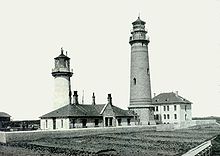Helgoland lighthouse
| Helgoland lighthouse | ||
|---|---|---|
| Helgoland lighthouse | ||
| Place: | Heligoland | |
| Location: | Helgoland Island, Oberland | |
| Geographical location: | 54 ° 10 '54.6 " N , 7 ° 52' 56.6" E | |
| Fire carrier height : | 35 | |
| Fire height : | 82 | |
|
|
||
| Identifier : | Blz. 5 s | |
| Scope knows: | 28 nm (51.9 km ) | |
| Operating mode: | electric, 2000 W - 230 V XBO xenon short-arc lamp | |
| Function: | Sea fire | |
| Operating time: | since 1952 | |
| International ordinal number: | B 1312 | |
The Helgoland lighthouse is located on the Oberland of the island of Helgoland . There is a radio tower in the immediate vicinity. The lighthouse was built in the Second World War as a flak tower or flak control station and was put into operation as a new lighthouse in 1952 as a replacement for the old one that was destroyed in the war. The tower has the strongest beacon on German lighthouses , which can be seen on clear nights from a distance of 28 nautical miles (e.g. on the East Frisian Islands in the south and in Eiderstedt in the east).
The Helgoland lighthouse is operated by the Tönning Waterways and Shipping Authority.
history
Heligoland's first lighthouse was built as early as 1811 under English rule. The so-called English lighthouse was 67 meters above sea level at the top . The Helgoland lighthouse was an important navigational aid in the German Bight, as its fire was visible about twice as far as that of the Cuxhaven lighthouse set up a few years earlier . The English lighthouse was demolished in 1902 after the new lighthouse went into operation. The lantern and the optics of the English Tower were brought to Fehmarn and installed on the newly built Staberhuk lighthouse in southeast Fehmarn, where they are still in use today.
The new lighthouse was commissioned by the Royal Prussian Building Administration in 1902 and was a brick round tower based on the same design as the Cape Arkona lighthouse on Rügen . It served from 1902 to 1945. During the British air raid on April 18, 1945, the tower was brought down. The lighthouse keeper was killed.
As early as 1941, the Wehrmacht had a square tower made of thick reinforced concrete built as an anti-aircraft control station, which was the only Heligoland building to withstand the war and the bunker systems on Heligoland by the British Army and the bombs thrown by the Royal Air Force . Today's lighthouse Helgoland was initially put into operation provisionally in 1952 in the flak tower. It has had its current appearance since a renovation in 1965. During the Cold War, a nuclear bunker was built in the lower two floors of the lighthouse ; the false windows on these floors were added for aesthetic reasons. The antenna systems for radar , a radio beacon , marine and directional radio were added later.
Nautical
The lighthouse serves as a sea fire. The characteristic identifier is a white flash every 5 seconds (Blz. 5s). The nominal range of the light signal is very high for lighthouses in German waters and is stated in official documents as 28 nm (52 km). On clear, but not too dry nights, the characteristic beam over the horizon can also be observed from the mainland in Harlesiel (50 km), Cuxhaven-Duhnen or Sankt Peter-Ording (48 km).
technology

The English lighthouse from 1811 was equipped with Argand lamps and reflectors. According to information from 1911, the tower, which was commissioned in 1902, was equipped with a flashing beacon whose range is said to have been 23.3 nautical miles.
The lighting system of today's tower was modernized in 1963. The optics consist of three ground converging lenses on two levels. They are arranged at an angle of 120 ° in an electrically operated bogie and have a focal length of 250 mm. A xenon high-pressure lamp with an output of 2000 watts is used as the light source . It produces a light of 35 million candelas .
The smaller Helgoland Düne beacon has been remote-controlled from the Helgoland lighthouse since 1982.
The Wilhelmshaven Waterways and Shipping Office uses the tower for its Helgoland relay radio station. With it, it regulates the traffic handling in the eastern German Bight (working channel 80/25 W duplex).
See also
Individual evidence
- ^ Russ Rowlett: Lighthouses of Germany: North Frisia ( English ) In: The Lighthouse Directory . University of North Carolina at Chapel Hill . Retrieved July 23, 2011.
- ↑ Beacon list of the Federal Maritime Shipping Office, Hamburg 2009
- ↑ http://home.arcor.de/frank.muelheims/leuchtturm/leuchttuerme_helgoland/body_leuchttuerme_helgoland.html ( Memento from May 22, 2009 in the Internet Archive )
- ↑ http://leuchtturmwelt.de/ltd/helgola/hl00.html



